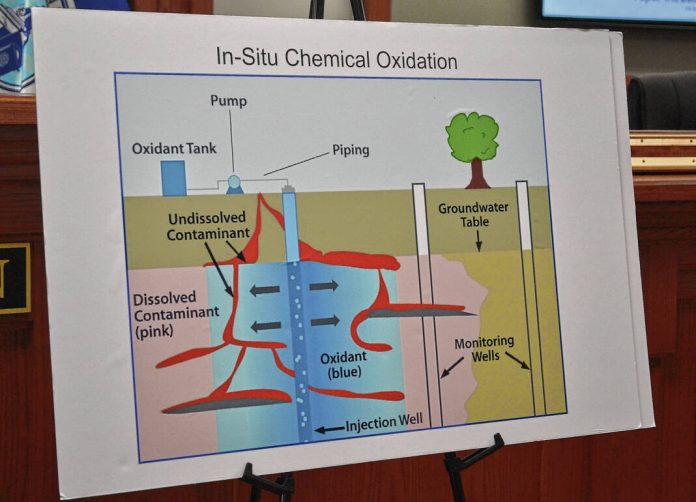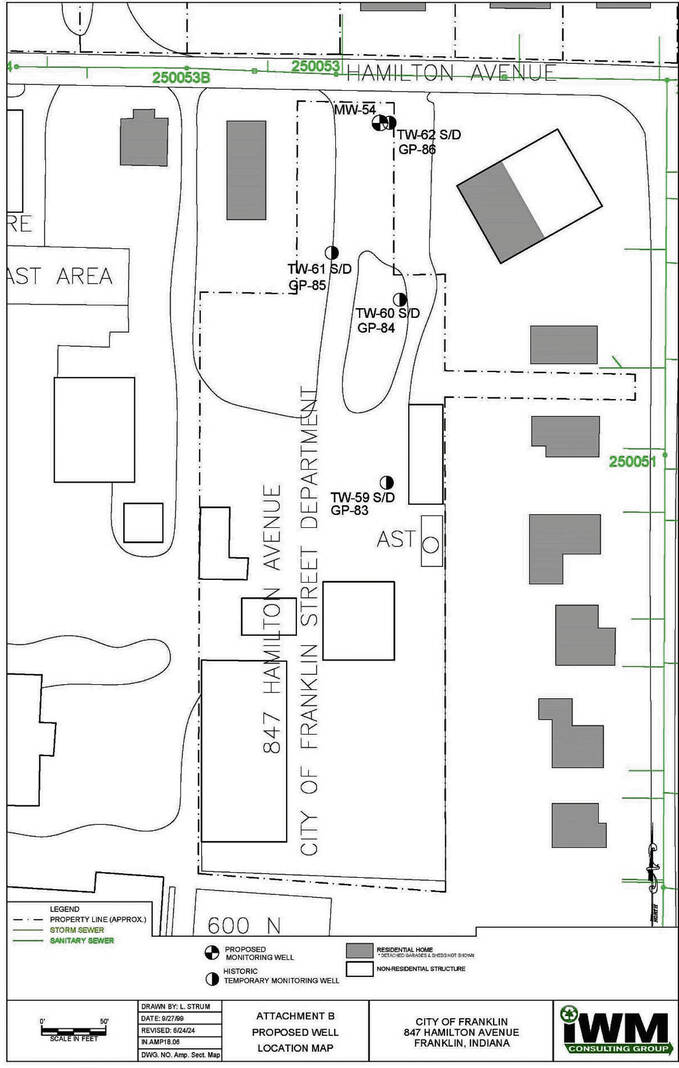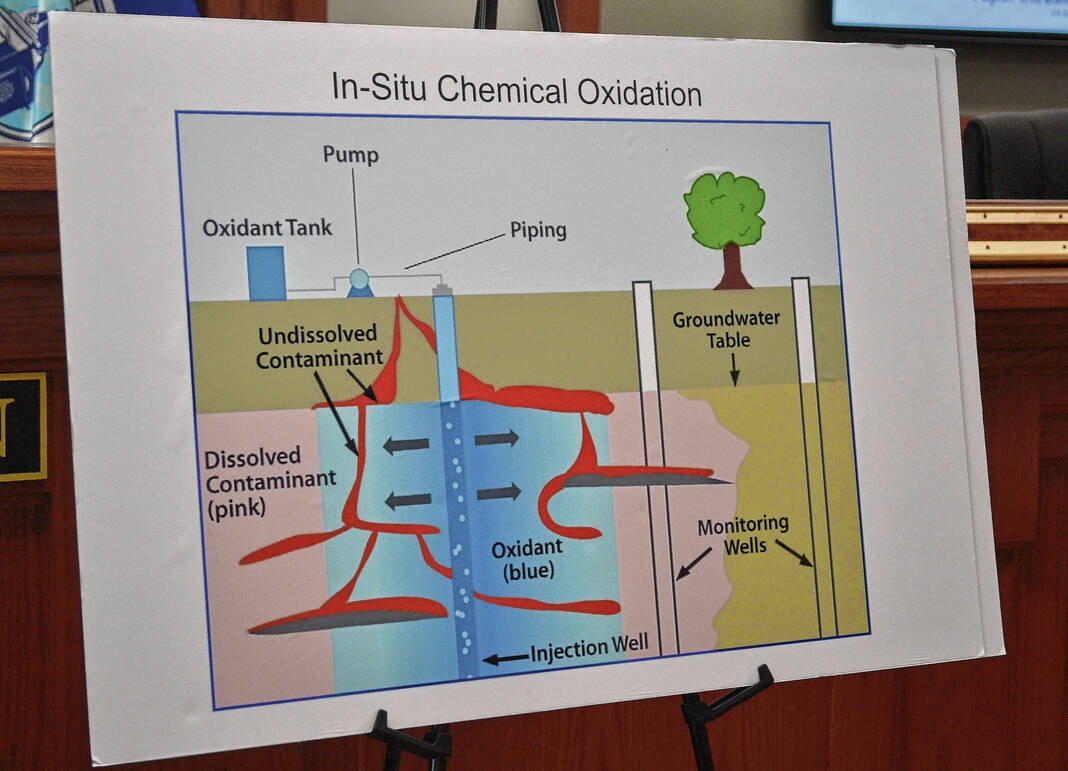After a long process, the Amphenol environmental clean-up is reaching its final stage in Franklin.
The Franklin Board of Public Works and Safety approved an access agreement with Amphenol Corp. on Monday to install an additional monitoring well in the northeast corner of the parking lot near Hamilton Avenue. The well is a final step in the ongoing environmental cleanup from contamination at the former Franklin Power Products and Bendix Corp. site.
The well is slated to be installed on July 8, said Chris Parks, senior project manager at IWM Consulting.
Starting around July 15, IWM Consulting will be injecting chemicals, or “bugs,” on the north and south side of Hamilton Avenue from the corner to around the intersection, Parks said at Monday’s meeting. Then, they will move south and move up Forsythe Street from the area near the creek.
The well will monitor what’s going on at the site after the chemicals have been injected. He said there are lots of monitoring wells on site. The wells will be monitored for five to 10 years depending on how quickly the chemicals react and if the company will need to do additional injections.
The chemicals being injected along Forsythe Street are mostly liquid carbon that is expected to absorb the chemicals from the existing contamination, Parks said. The company will also inject a mixure of other elements to create an anaerobic reaction that will break down the chemicals into non-harmful byproducts.
Amphenol is solely responsible for the operation, maintenance, installation and associated costs of the well, according to the agreement. After monitoring effects have been completed, Amphenol has also agreed to properly remove and abandon the well in accordance with state requirements.
The clean-up plan, also known as the secondary supplemental corrective action implementation plan, was approved in April, said Macy Pressley, a spokesperson for the U.S. Environmental Protection Agency.
She said there are currently 27 wells proposed for the monitoring program, including 22 that already exist and five that will be constructed as part of the final remedy in Franklin.
Franklin Mayor Steve Barnett sees the installation of the new well as a final step in a long process.
“This started for us six years ago — on July the 8th — and we feel like we’re at our final stage,” Barnett said at Monday’s meeting. “… This is not a dangerous situation. This is just to monitor to make sure it’s not a dangerous situation. We are getting to the end of this Amphenol situation.”
Site history
The situation stemmed from contamination that had accumulated at the site for over 22 years when Bendix operated at the site, 80 Hurricane Rd./400 N. Forsythe St., from 1961 to 1983.
Within that period, chemicals from plating operations at the site were routed into a sanitary sewer manhole and discharged into the municipal sanitary sewer system, and on-site spills migrated to the soil beneath the building through cracks in the foundation.
Volatile organic compounds, or VOC, seeped into the soil and groundwater, including trichloroethylene, or TCE, and tetrachloroethylene, or PCE. These chemicals are known carcinogens, but the contamination at the site and nearby properties wasn’t a high enough concentration to cause cancer.
According to a Health and Hazard Assessment report from the U.S. Department of Health and Human Services Agency for Toxic Substances and Disease Registry, or ATSDR, samples gathered at the site helped determine there wasn’t enough contamination in any home or business to cause cancer.
Only two homes and one business had any level of contamination that could be traced to Amphenol or nearby sites, and for those sites affected, it was at a level that would only be harmful to a fetus if a pregnant woman was exposed to the toxin.
The contamination was first known to be an issue in 1984 after Bendix was purchased by Amphenol/Franklin Power Products, but no action was taken to clean it up at the time. Three cleanup orders have been initiated at the site since 1990, the first resulting in a pump and treat system that will be decommissioned as part of the final clean-up plan.
Most recently, an order was issued in 2018 after it was revealed there could be additional contamination not cleaned up in the previous orders. People began to speak about pediatric cancer, fueling efforts to ensure the site is fully remediated. People spoke out with concern there was a cancer cluster at the site, however, state health officials debunked this concern.
Vapor mitigation systems were installed in homes that tested over screening levels, sanitary sewers that were impacted by the contamination were replaced or relined to seal out contaminants and sewer laterals and/or plumbing systems were also replaced in impacted homes.
Barnett previously said risk to area residents has been mitigated for several years. He, other city officials and the city’s consultant Enviroforensics have been working with the EPA for nearly six years to make sure the site was cleaned up properly, he previously said.
“To me, that (cleaning up the site) means more than all the pretty stuff that we’ve actually seen going up,” Barnett previously said. “This is actually doing something that matters as people’s lives and their health, so I feel good about that.”
Clean up plans
The EPA’s final remediation plan includes several methods to clean up the site and long-term monitoring.
Technologies such as In-Situ Chemical Oxidation, or ISCO, and In-Situ Chemical Reduction, or ISCR, will be used in concert with Permeable Reactive Barriers, or PRB, and/or bioremediation. These processes are designed to inject reactive chemicals into the ground to break down the contaminants, said Chris Black, the EPA’s corrective action project manager for the site, at a June 9, 2022 public meeting.
The process to carry out ICSO and ISCR involves a machine pressing steel rods into the ground at an appropriate depth to reach the contamination, then injecting carbon-based material into the ground to counteract the contamination, Casey McFall, the city’s consultant with Enviroforensics, previously said.
A permeable barrier will also be inserted into the ground to catch contaminants while allowing the groundwater to move freely, he said.
The injected material and permeable barrier are made of propriety substances that are essentially food for bacteria that are already in the ground, McFall said. They’re designed to promote bacteria growth, which will help reduce the contamination over time.
“You inject it in the ground and let it work, but you have to monitor,” he said. “So, there’ll be groundwater monitoring wells already around there. And they’ll be monitoring those to see the effectiveness of putting the barrier in. What should happen is the concentration of contaminant in those groundwater wells should drop.”
Monitoring will continue as long as it takes for the chemical reactions to work, Black previously said.
“It is not a leave-it-alone remedy. We are going to monitor this over time and we are going to do a statistical method that determines if it is going to meet this goal in a specific amount of time. If it doesn’t we will try another remedy,” Black said. “It is part of a long-term remedy plan – we are not walking away.”
The EPA will also be hosting an open house for the public to ask questions about the clean-up efforts from 5:30 to 7 p.m. Aug. 7 at the Franklin branch of the Johnson County Public Library.
IF YOU GO
Amphenol Open House
What: An EPA-hosted event to give Franklin residents an opportunity to ask lingering questions about what work is happening for the Amphenol site clean-up. Work will consist of installing permeable reactive barriers, or PRBs, to treat impacted soil while continuing to monitor area groundwater.
When: 5:30 to 7 p.m. Aug. 7
Where: Historical Room at the Franklin branch of the Johnson County Public Library, 401 State St.
Information: EPA Community Involvement Coordinator Kirstin Safakas, [email protected] or 312-919-4621








